Radon Investigation in 650 Energy Efficient Dwellings in Western Switzerland: Impact of Energy Renovation and Building Characteristics
Abstract
1. Introduction
2. Materials and Methods
2.1. Study Sample and Approach
2.2. Characteristics of Selected Dwellings
2.3. Radon Measurement
2.4. Statistical Analyses
3. Results and Discussion
3.1. Radon Concentration
3.2. Associations with Dwelling Characteristics
3.3. Influence of Thermal Retrofitting
3.4. Implications
4. Conclusions
Supplementary Materials
Author Contributions
Funding
Acknowledgments
Conflicts of Interest
References
- Clement, C. Assessment of the detriment from exposure to radon and its progeny. Ann. ICRP 2010, 40, 41e7. [Google Scholar]
- Pacheco-Torgal, F. Indoor radon: An overview on a perennial problem. Build. Environ. 2012, 58, 270–277. [Google Scholar] [CrossRef]
- Al-Zoughool, M.; Krewski, D. Health effects of radon: A review of the literature. Int. J. Radiat. Biol. 2009, 85, 57–69. [Google Scholar] [CrossRef] [PubMed]
- Chauhan, V.; Howland, M.; Mendenhall, A.; O’Hara, S.; Stocki, T.J.; McNamee, J.P.; Wilkins, R.C. Effects of alpha particle radiation on gene expression in human pulmonary epithelial cells. Int. J. Hyg. Environ. Health 2012, 215, 522–535. [Google Scholar] [CrossRef] [PubMed]
- World Health Organization. WHO Handbook on Indoor Radon: A Public Health Perspective; World Health Organization: Geneva, Switzerland, 2009. [Google Scholar]
- Chen, J.; Harley, N.H. A review of indoor and outdoor radon equilibrium factors—Part I: 222Rn. Health Phys. 2018, 115, 490–499. [Google Scholar] [CrossRef] [PubMed]
- Bruno, R.C. Sources of indoor radon in houses: A review. J. Air Pollut. Control. Assoc. 1983, 33, 105–109. [Google Scholar] [CrossRef]
- Nazaroff, W.W. Radon transport from soil to air. Rev. Geophys. 1992, 30, 137–160. [Google Scholar] [CrossRef]
- Darby, S.; Hill, D.; Auvinen, A.; Barros-Dios, J.M.; Baysson, H.; Bochicchio, F.; Deo, H.; Falk, R.; Forastiere, F.; Hakama, M.; et al. Radon in homes and risk of lung cancer: Collaborative analysis of individual data from 13 European case-control studies. BMJ 2005, 330, 223. [Google Scholar] [CrossRef]
- Darby, S.; Hill, D.; Deo, H.; Auvinen, A.; Barros-Dios, J.M.; Baysson, H.; Bochicchio, F.; Falk, R.; Farchi, S.; Figueiras, A.; et al. Residential radon and lung cancer--detailed results of a collaborative analysis of individual data on 7148 persons with lung cancer and 14 208 persons without lung cancer from 13 epidemiologic studies in Europe. Scand. J. Work Environ. Health 2006, 32 (Suppl. 1), 1–83. [Google Scholar]
- Krewski, D.; Lubin, J.H.; Zielinski, J.M.; Alavanja, M.; Catalan, V.S.; Field, R.W.; Klotz, J.B.; Létourneau, E.G.; Lynch, C.F.; Lyon, J.I.; et al. Residential radon and risk of lung cancer: A combined analysis of 7 North American case-control studies. Epidemiology 2005, 16, 137–145. [Google Scholar] [CrossRef]
- Krewski, D.; Lubin, J.H.; Zielinski, J.M.; Alavanja, M.; Catalan, V.S.; Field, R.W.; Klotz, J.B.; Létourneau, E.G.; Lynch, C.F.; Lyon, J.L.; et al. A combined analysis of North American case-control studies of residential radon and lung cancer. J. Toxicol. Environ. Health A 2006, 69, 533–597. [Google Scholar] [CrossRef] [PubMed]
- US Environmental Protection Agency. A Citizen’s Guide to Radon: The Guide to Protecting Yourself and Your Family from Radon. Available online: https://www.epa.gov/sites/production/files/2016-12/documents/2016_a_citizens_guide_to_radon.pdf (accessed on 14 June 2019).
- Swiss Federal Council. Radiological Protection Ordinance. Available online: https://www.admin.ch/opc/en/classified-compilation/20163016/index.html (accessed on 14 June 2019).
- EU Council. COUNCIL DIRECTIVE 2013/59/EURATOM. Available online: https://eur-lex.europa.eu/LexUriServ/LexUriServ.do?uri=OJ:L:2014:013:0001:0073:EN:PDF (accessed on 22 November 2019).
- Nero, A.V.; Schwehr, M.B.; Nazaroff, W.W.; Revzan, K.L. Distribution of airborne radon-222 concentrations in US homes. Science 1986, 234, 992–997. [Google Scholar] [CrossRef] [PubMed]
- Bochicchio, F.; Venuti, G.C.; Nuccetelli, C.; Piermattei, S.; Risica, S.; Tommasino, L.; Torri, G. Results of the representative Italian national survey on radon indoors. Health Phys. 1996, 71, 741–748. [Google Scholar] [CrossRef] [PubMed]
- Quindós, L.S.; Fernández, P.L.; Soto, J. National survey on indoor radon in Spain. Environ. Int. 1991, 17, 449–453. [Google Scholar] [CrossRef]
- Franco-Marina, F.; Segovia, N.; Ruiz, W.; Godinez, L.; Tavera, L.; Lopez, A.; Chavez, A.; Peña, P.; Ponciano, G. Short and long term indoor radon survey in Mexico City. Radiat. Meas. 2001, 34, 545–548. [Google Scholar] [CrossRef]
- Al-Jarallah, M.I.; Abu-Jarad, F.; Al-Shukri, A. Indoor radon measurements in dwellings of four Saudi Arabian cities. Radiat. Meas. 2003, 36, 445–448. [Google Scholar] [CrossRef]
- Kim, C.K.; Lee, S.C.; Lee, D.M.; Chang, B.U.; Rho, B.H.; Kang, H.D. Nationwide survey of radon levels in Korea. Health Phys. 2003, 84, 354–360. [Google Scholar] [CrossRef]
- Dubois, G.; Bossew, P.; Tollefsen, T.; De Cort, M. First steps towards a European atlas of natural radiation: Status of the European indoor radon map. J. Environ. Radioact. 2010, 101, 786–798. [Google Scholar] [CrossRef]
- Gruber, V.; Bossew, P.; De Cort, M.; Tollefsen, T. The European map of the geogenic radon potential. J. Radiol. Prot. 2013, 33, 51. [Google Scholar] [CrossRef]
- Demoury, C.; Ielsch, G.; Hemon, D.; Laurent, O.; Laurier, D.; Clavel, J.; Guillevic, J. A statistical evaluation of the influence of housing characteristics and geogenic radon potential on indoor radon concentrations in France. J. Environ. Radioact. 2013, 126, 216–225. [Google Scholar] [CrossRef]
- Collignan, B.; Le Ponner, E.; Mandin, C. Relationships between indoor radon concentrations, thermal retrofit and dwelling characteristics. J. Environ. Radioact. 2016, 165, 124–130. [Google Scholar] [CrossRef]
- Andersen, C.E.; Raaschou-Nielsen, O.; Andersen, H.P.; Lind, M.; Gravesen, P.; Thomsen, B.L.; Ulbak, K. Prediction of 222Rn in Danish dwellings using geology and house construction information from central databases. Radiat. Prot. Dosimetry 2007, 123, 83–94. [Google Scholar] [CrossRef]
- Hunter, N.; Muirhead, C.R.; Miles, J.C.; Appleton, J.D. Uncertainties in radon related to house-specific factors and proximity to geological boundaries in England. Radiat. Prot. Dosimetry 2009, 136, 17–22. [Google Scholar] [CrossRef] [PubMed]
- Gerken, M.; Kreienbrock, L.; Wellmann, J.; Kreuzer, M.; Wichmann, H.E. Models for retrospective quantification of indoor radon exposure in case-control studies. Health Phys. 2000, 78, 268–278. [Google Scholar] [CrossRef] [PubMed]
- Verdi, L.; Weber, A.; Stoppa, G. Indoor radon concentration forecasting in South Tyrol. Radiat. Prot. Dosimetry 2004, 111, 435–438. [Google Scholar] [CrossRef] [PubMed]
- Kropat, G.; Bochud, F.; Jaboyedoff, M.; Laedermann, J.P.; Murith, C.; Palacios, M.; Baechler, S. Major influencing factors of indoor radon concentrations in Switzerland. J. Environ. Radioact. 2014, 129, 7–22. [Google Scholar] [CrossRef]
- Hauri, D.D.; Huss, A.; Zimmermann, F.; Kuehni, C.E.; Röösli, M. A prediction model for assessing residential radon concentration in Switzerland. J. Environ. Radioact. 2012, 112, 83–89. [Google Scholar] [CrossRef]
- Yarmoshenko, I.V.; Vasilyev, A.V.; Onishchenko, A.D.; Kiselev, S.M.; Zhukovsky, M.V. Indoor radon problem in energy efficient multi-storey buildings. Radiat. Prot. Dosimetry 2014, 160, 53–56. [Google Scholar] [CrossRef]
- Vasilyev, A.V.; Yarmoshenko, I.V.; Zhukovsky, M.V. Low air exchange rate causes high indoor radon concentration in energy-efficient buildings. Radiat. Prot. Dosimetry 2015, 164, 601–605. [Google Scholar] [CrossRef]
- Meyer, W. Impact of constructional energy-saving measures on radon levels indoors. Indoor Air 2019, 29, 680–685. [Google Scholar] [CrossRef]
- Pigg, S.; Cautley, D.; Francisco, P.W. Impacts of weatherization on indoor air quality: A field study of 514 homes. Indoor Air 2018, 28, 307–317. [Google Scholar] [CrossRef] [PubMed]
- Du, L.; Leivo, V.; Prasauskas, T.; Täubel, M.; Martuzevicius, D.; Haverinen-Shaughnessy, U. Effects of energy retrofits on Indoor Air Quality in multifamily buildings. Indoor Air 2019, 29, 686–697. [Google Scholar] [CrossRef] [PubMed]
- Jiránek, M.; Kačmaříková, V. Dealing with the increased radon concentration in thermally retrofitted buildings. Radiat. Prot. Dosimetry 2014, 160, 43–47. [Google Scholar] [CrossRef] [PubMed]
- Symonds, P.; Rees, D.; Daraktchieva, Z.; McColl, N.; Bradley, J.; Hamilton, I.; Davies, M. Home energy efficiency and radon: An observational study. Indoor Air 2019, 29, 854–864. [Google Scholar] [CrossRef] [PubMed]
- Swiss Federal Council. Energy Strategy 2050. Available online: https://www.bfe.admin.ch/bfe/en/home/policy/energy-strategy-2050.html (accessed on 14 June 2019).
- Swiss Federal Office of Energy. Programme Bâtiment. Available online: https://www.dasgebaeudeprogramm.ch/de/ (accessed on 14 June 2019).
- Minergie Schweiz. Available online: https://www.minergie.ch (accessed on 14 June 2019).
- Swiss Federal Office of Public Health. Available online: https://www.ch-radon.ch (accessed on 14 June 2019).
- Pampuri, L.; Caputo, P.; Valsangiacomo, C. Effects of buildings’ refurbishment on indoor air quality. Results of a wide survey on radon concentrations before and after energy retrofit interventions. Sustain. Cities Soc. 2018, 42, 100–106. [Google Scholar] [CrossRef]
- Ordonnance sur la Radioprotection (ORaP). Available online: https://www.admin.ch/opc/fr/classified-compilation/19940157/201401010000/814.501.pdf (accessed on 14 June 2019).
- ISO 11665-8. Measurement of Radioactivity in the Environment—Air: Radon-222. Part. 8: Methodologies for Initial and Additional Investigations in Buildings; International Organization for Standardization: Geneva, Switzerland, 2012. [Google Scholar]
- ISO 11665-4. Measurement of Radioactivity in the Environment—Air: Radon-222. Part. 4: Integrated Measurement Method for Determining Average Activity Concentration Using Passive Sampling and Delayed Analysis; International Organization for Standardization: Geneva, Switzerland, 2012. [Google Scholar]
- Chen, J.; Ford, K.L. A study on the correlation between soil radon potential and average indoor radon potential in Canadian cities. J. Environ. Radioact. 2017, 166, 152–156. [Google Scholar] [CrossRef]
- Collignan, B.; Powaga, E. Impact of ventilation systems and energy savings in a building on the mechanisms governing the indoor radon activity concentration. J. Environ. Radioact. 2019, 196, 268–273. [Google Scholar] [CrossRef]
- Diallo, T.M.; Collignan, B.; Allard, F. Analytical quantification of airflows from soil through building substructures. Build. Simul. 2013, 6, 81–94. [Google Scholar] [CrossRef]
- Földváry, V.; Bekö, G.; Langer, S.; Arrhenius, K.; Petráš, D. Effect of energy renovation on indoor air quality in multifamily residential buildings in Slovakia. Build. Environ. 2017, 122, 363–372. [Google Scholar] [CrossRef]
- SIA 180/2014. Thermal Insulation, Moisture Protection and Indoor Climate in Buildings; Swiss Society of Engineers and Architects: Zurich, Switzerland, 2014. [Google Scholar]
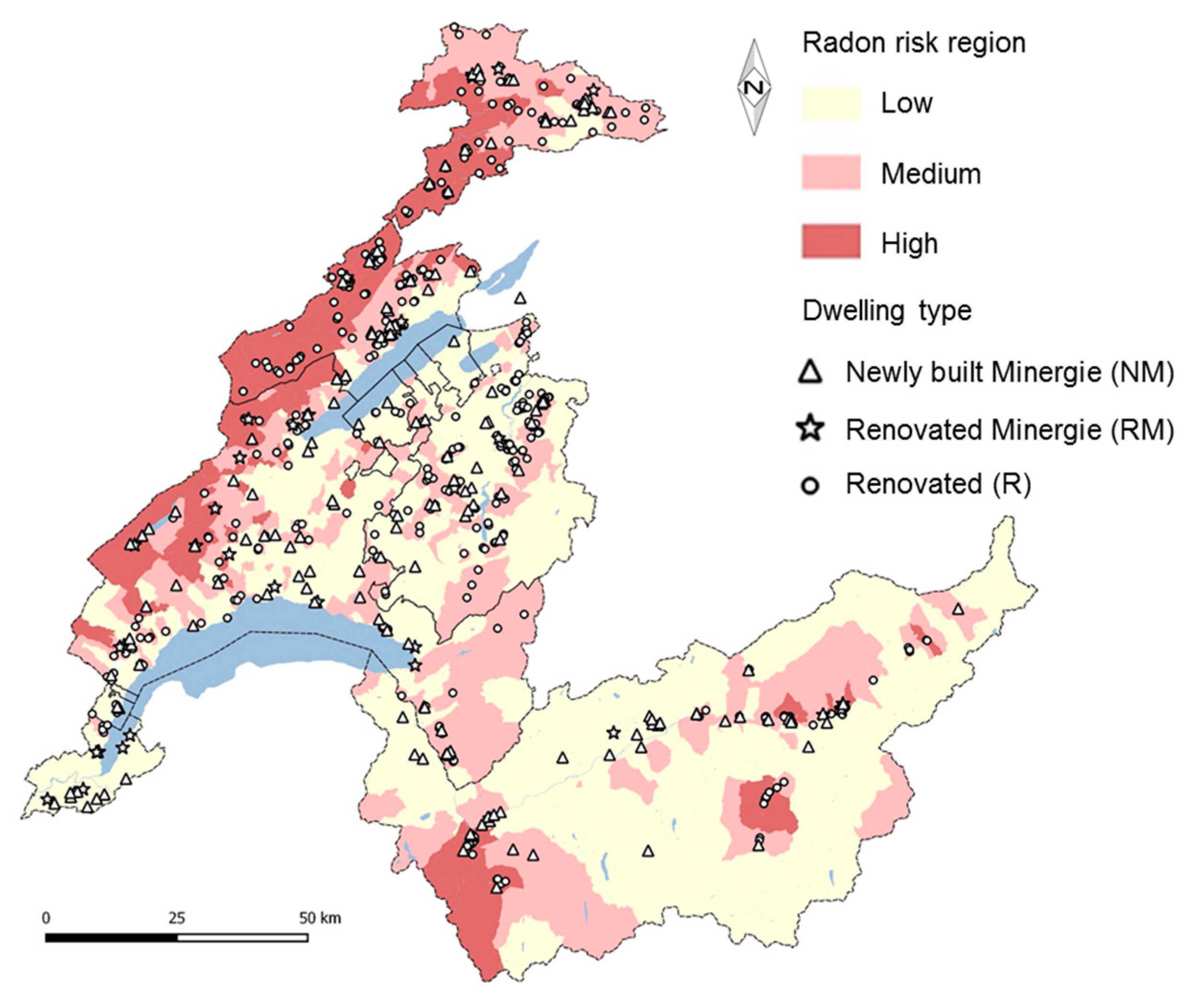
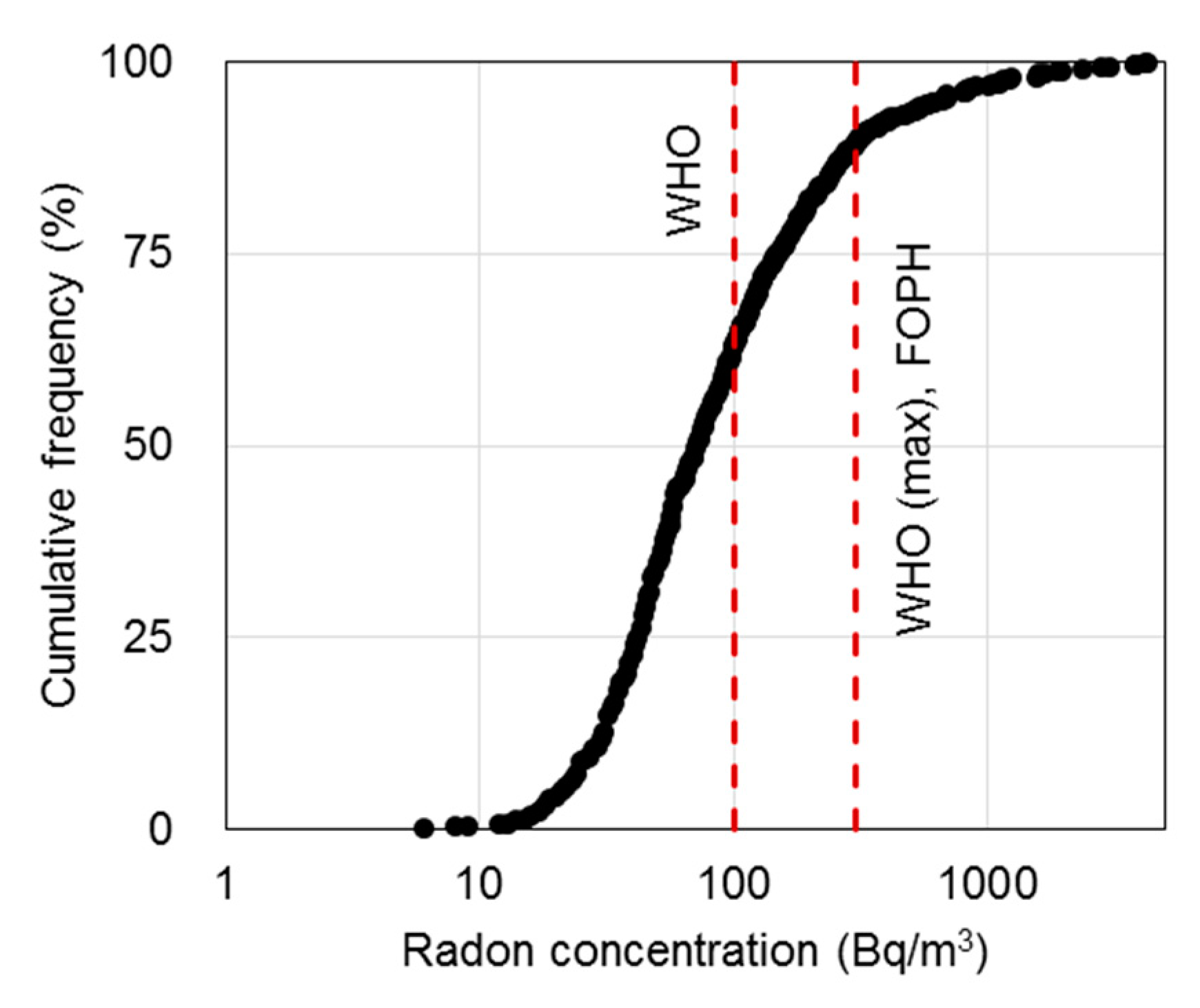

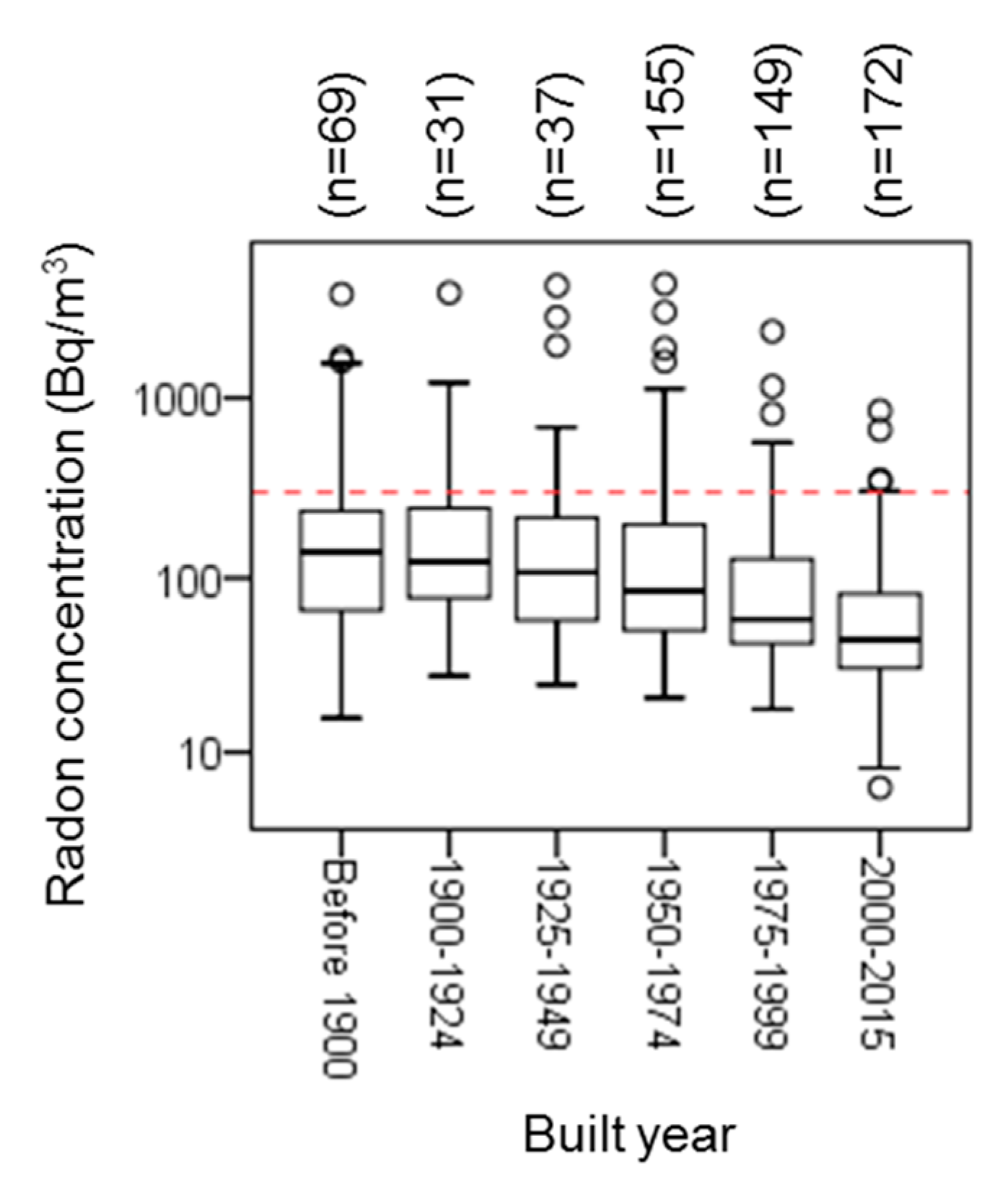

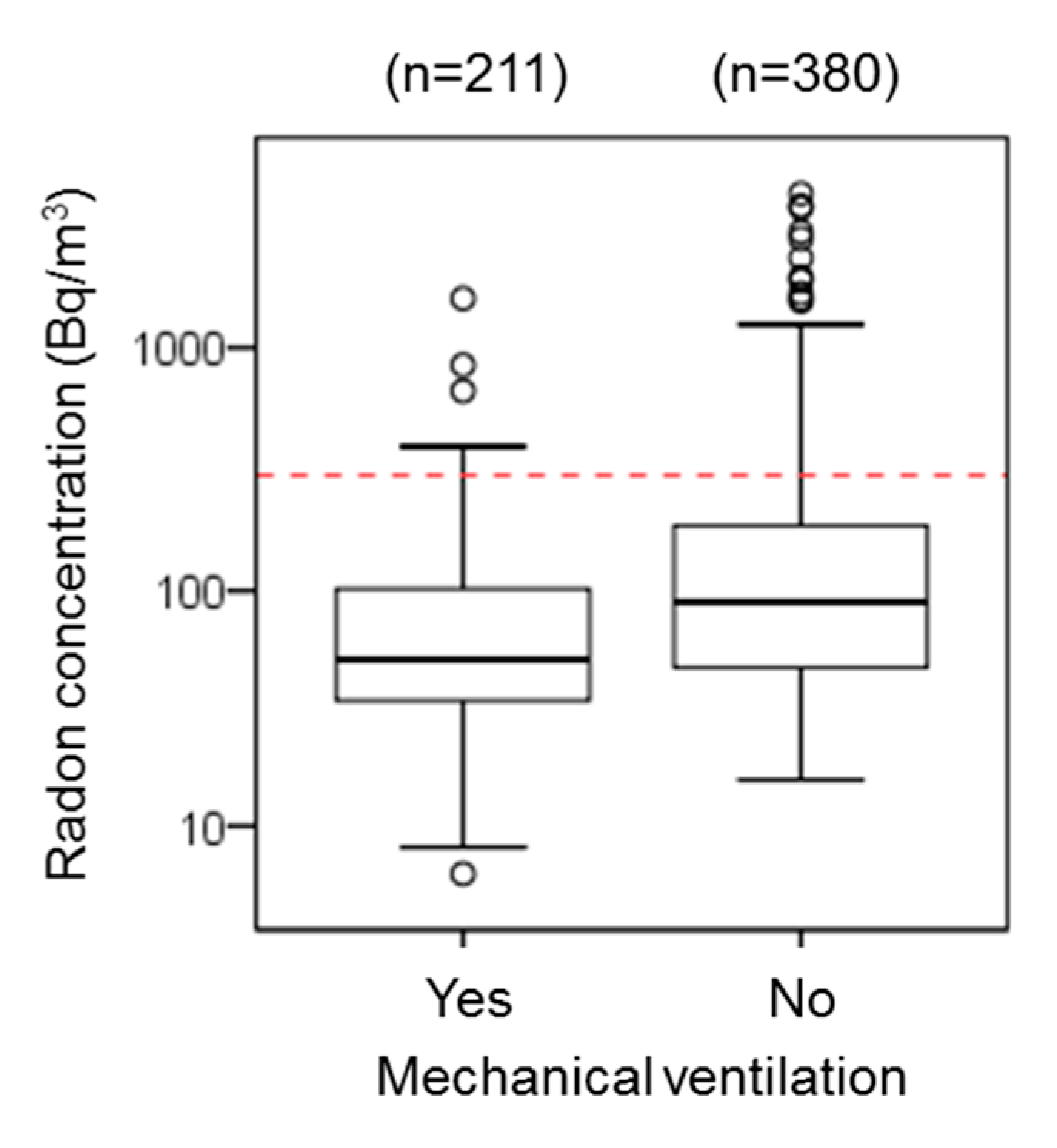
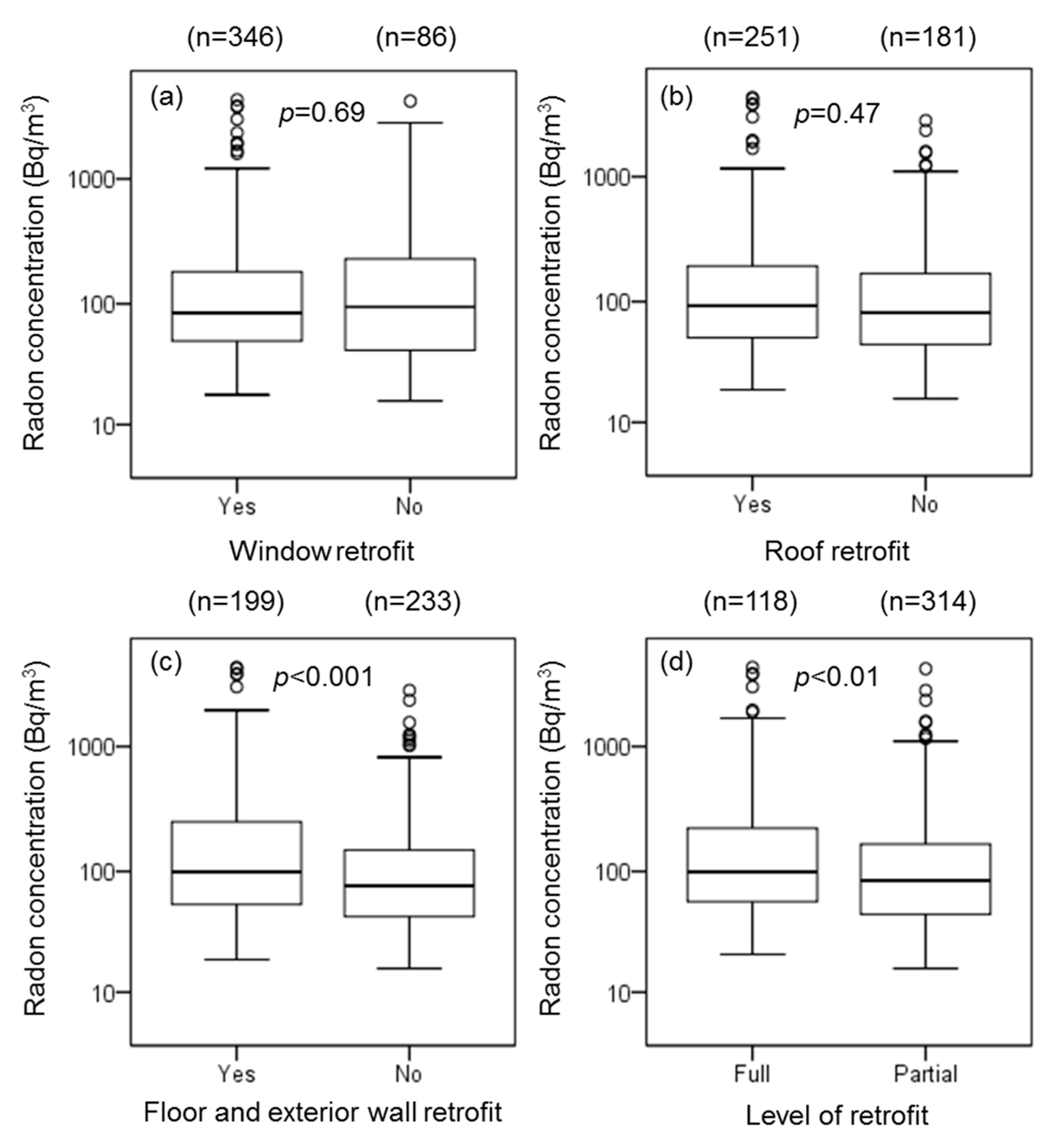
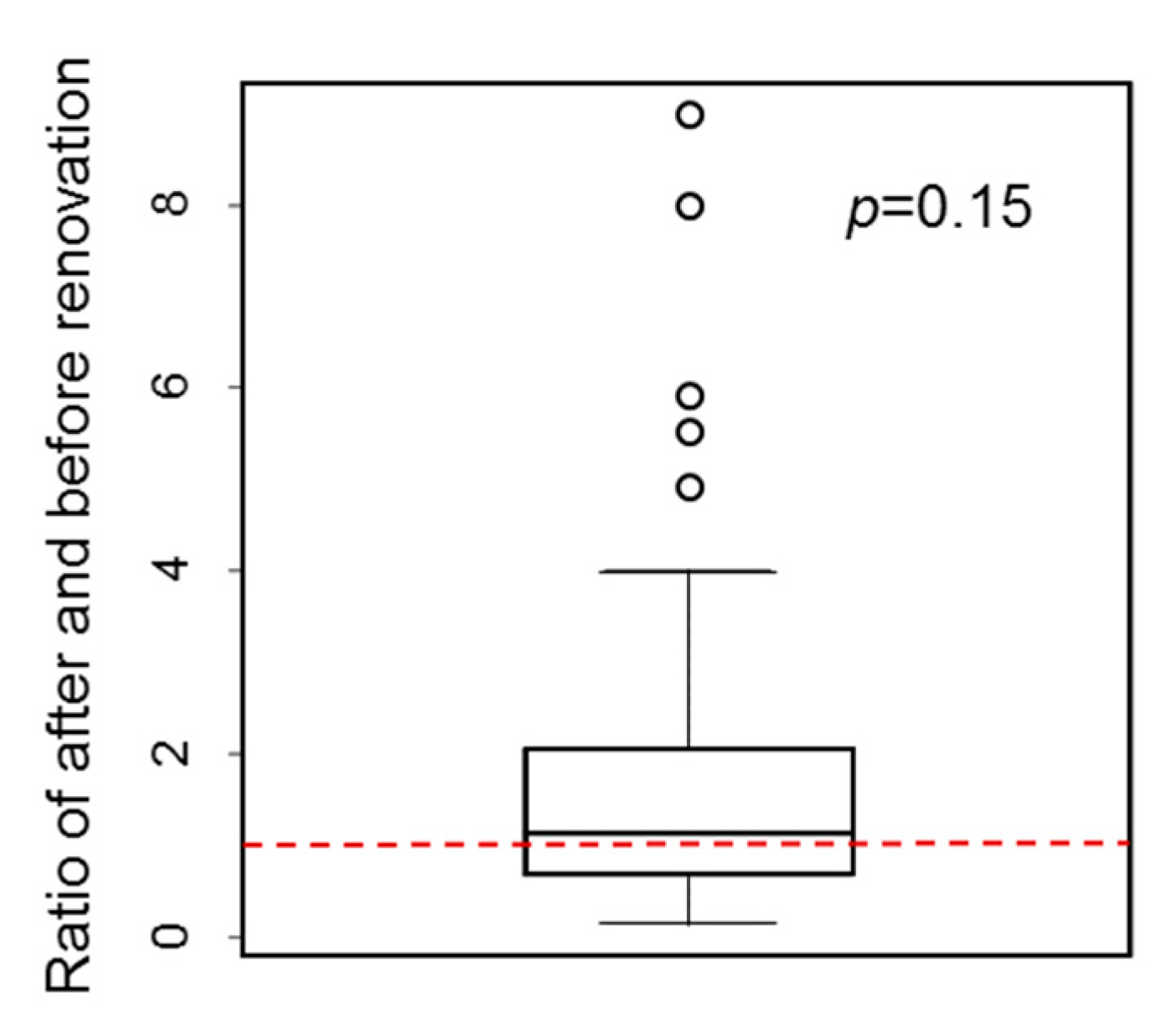
| Dwelling Characteristics | NM No. (%) | RM No. (%) | R No. (%) | Total No. (%) | |
|---|---|---|---|---|---|
| Built Year | 2000–2015 | 169 (99) | 2 (6) | 1 (0) | 172 (28) |
| 1975–1999 | 1 (1) | 5 (16) | 143 (35) | 149 (25) | |
| 1950–1974 | 0 (0) | 9 (29) | 146 (35) | 155 (25) | |
| 1925–1949 | 0 (0) | 3 (10) | 34 (8) | 37 (6) | |
| 1900–1924 | 0 (0) | 4 (13) | 27 (7) | 31 (5) | |
| Before 1900 | 0 (0) | 8 (26) | 61 (15) | 69 (11) | |
| Building Structure | Masonry | 78 (46) | 11 (35) | 261 (63) | 350 (57) |
| Wood | 56 (33) | 2 (6) | 12 (3) | 70 (11) | |
| Mixed | 29 (17) | 17 (53) | 103 (25) | 149 (24) | |
| Other or not clear | 7 (4) | 2 (6) | 38 (9) | 47 (8) | |
| Radon Risk Region | Low | 57 (34) | 9 (28) | 67 (16) | 133 (21) |
| Medium | 87 (51) | 19 (59) | 225 (54) | 331 (54) | |
| High | 26 (15) | 4 (13) | 122 (30) | 152 (25) | |
| Mechanical Ventilation | Yes | 168 (99) | 29 (90) | 14 (4) | 211 (36) |
| No | 1 (1) | 3 (10) | 376 (96) | 380 (64) | |
| Basement Type | Completely excavated | 50 (30) | 8 (25) | 126 (31) | 184 (30) |
| Semi-excavated | 27 (16) | 8 (25) | 82 (20) | 117 (19) | |
| Back-grounded | 46 (28) | 12 (38) | 156 (38) | 214 (35) | |
| No basement | 44 (26) | 4 (12) | 47 (11) | 95 (16) | |
| Garage Type | Outdoor | 43 (27) | 19 (61) | 123 (30) | 185 (31) |
| Independent | 40 (25) | 5 (16) | 113 (28) | 158 (27) | |
| Attached | 42 (27) | 5 (16) | 97 (24) | 144 (24) | |
| In basement | 33 (21) | 2 (7) | 72 (18) | 107 (18) | |
| Natural Ground | Yes | 46 (28) | 14 (44) | 204 (52) | 264 (45) |
| No | 119 (72) | 18 (56) | 192 (49) | 329 (55) | |
| Thermal retrofitting | |||||
| Window | Yes | -- | 12 (60) | 334 (81) | 346 (80) |
| No | -- | 8 (40) | 78 (19) | 86 (20) | |
| Roof | Yes | -- | 13 (65) | 238 (58) | 251 (58) |
| No | -- | 7 (35) | 174 (42) | 181 (42) | |
| Floor and Exterior Wall | Yes | -- | 14 (70) | 185 (45) | 199 (46) |
| No | -- | 6 (30) | 227 (55) | 233 (54) | |
| Level of Retrofit | Partial | -- | 9 (45) | 305 (74) | 314 (73) |
| Full | -- | 11 (55) | 107 (26) | 118 (27) | |
© 2019 by the authors. Licensee MDPI, Basel, Switzerland. This article is an open access article distributed under the terms and conditions of the Creative Commons Attribution (CC BY) license (http://creativecommons.org/licenses/by/4.0/).
Share and Cite
Yang, S.; Goyette Pernot, J.; Hager Jörin, C.; Niculita-Hirzel, H.; Perret, V.; Licina, D. Radon Investigation in 650 Energy Efficient Dwellings in Western Switzerland: Impact of Energy Renovation and Building Characteristics. Atmosphere 2019, 10, 777. https://doi.org/10.3390/atmos10120777
Yang S, Goyette Pernot J, Hager Jörin C, Niculita-Hirzel H, Perret V, Licina D. Radon Investigation in 650 Energy Efficient Dwellings in Western Switzerland: Impact of Energy Renovation and Building Characteristics. Atmosphere. 2019; 10(12):777. https://doi.org/10.3390/atmos10120777
Chicago/Turabian StyleYang, Shen, Joëlle Goyette Pernot, Corinne Hager Jörin, Hélène Niculita-Hirzel, Vincent Perret, and Dusan Licina. 2019. "Radon Investigation in 650 Energy Efficient Dwellings in Western Switzerland: Impact of Energy Renovation and Building Characteristics" Atmosphere 10, no. 12: 777. https://doi.org/10.3390/atmos10120777
APA StyleYang, S., Goyette Pernot, J., Hager Jörin, C., Niculita-Hirzel, H., Perret, V., & Licina, D. (2019). Radon Investigation in 650 Energy Efficient Dwellings in Western Switzerland: Impact of Energy Renovation and Building Characteristics. Atmosphere, 10(12), 777. https://doi.org/10.3390/atmos10120777






